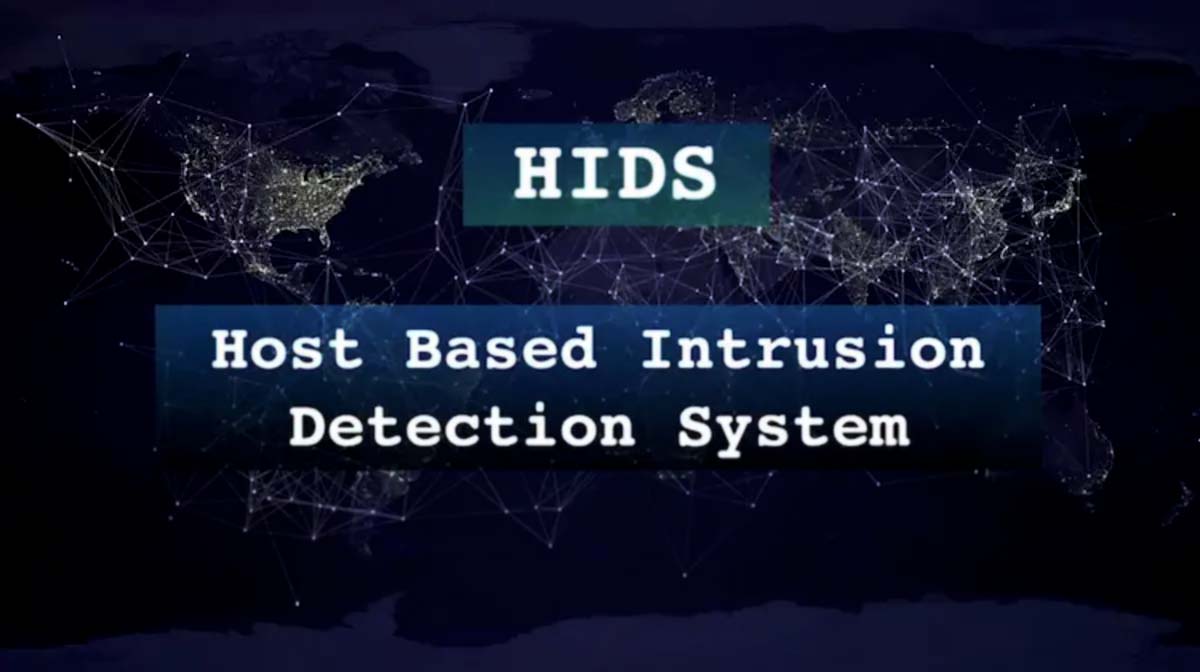Home>Home Security and Surveillance>What Do Host-Based Intrusion Detection Systems Offer


Home Security and Surveillance
What Do Host-Based Intrusion Detection Systems Offer
Modified: March 21, 2024
Learn how host-based intrusion detection systems contribute to home security and surveillance. Enhance the protection of your home with efficient detection and prevention mechanisms.
(Many of the links in this article redirect to a specific reviewed product. Your purchase of these products through affiliate links helps to generate commission for Storables.com, at no extra cost. Learn more)
Introduction
Welcome to the world of home security and surveillance, where peace of mind meets technological innovation. In today’s rapidly advancing digital age, the need for robust home security solutions has become increasingly vital. As homeowners, we desire to protect our loved ones and our valuable possessions from the ever-present threat of intrusion and theft. That is where host-based intrusion detection systems come into play.
In this comprehensive guide, we will delve into the world of host-based intrusion detection systems and explore the benefits they offer in safeguarding our homes. We will discuss the definition of host-based intrusion detection systems, their different types, features, and capabilities. Additionally, we will address the benefits of using these systems, as well as their limitations. Moreover, we will compare host-based intrusion detection systems with network-based intrusion detection systems to provide a holistic understanding of the two.
We will also provide you with best practices for implementing host-based intrusion detection systems and share real-life case studies of successful implementations. Whether you are looking to upgrade your existing home security system or are considering implementing one for the first time, this guide will equip you with the knowledge necessary to make informed decisions and enhance the security of your home.
So, buckle up and get ready to explore the exciting realm of host-based intrusion detection systems as we delve into the intricacies and advantages they bring to the table.
Key Takeaways:
- Host-Based Intrusion Detection Systems (HIDS) provide real-time monitoring and early threat detection for home networks. They offer granular visibility into host activities, enhancing security and providing peace of mind to homeowners.
- HIDS, when implemented effectively, offer comprehensive security coverage and protection against insider threats. By following best practices and integrating with other security measures, homeowners can safeguard their networks and respond swiftly to potential security incidents.
Definition of Host-Based Intrusion Detection Systems
Host-Based Intrusion Detection Systems (HIDS) are a crucial component of a comprehensive home security system. They are designed to monitor and analyze the activities and behaviors of individual hosts or devices within a network. Unlike network-based intrusion detection systems that focus on monitoring network traffic, HIDS monitor the activities occurring directly on the host, such as computers, servers, or IoT devices.
The primary objective of a HIDS is to identify and mitigate potential security breaches and unauthorized activities that may compromise the integrity, confidentiality, and availability of a system. This is achieved by continuously monitoring the host’s behavior, comparing it with predefined security policies, and triggering alerts or taking appropriate actions if any suspicious or malicious activities are detected.
Host-based intrusion detection systems operate on the principle of anomaly detection and signature-based detection. Anomaly detection involves learning the normal behavior of the host and then identifying any deviations from it. This technique is effective in detecting new and unknown threats that may not have known signatures. Signature-based detection, on the other hand, involves comparing the activities on the host against a database of known attack signatures to identify any matches.
HIDS can monitor various aspects of the host’s activities, including file integrity, user authentication, process monitoring, and network connections. By analyzing these activities, HIDS can detect and respond to various types of intrusions, such as unauthorized access attempts, malware infections, suspicious network connections, and unauthorized changes to critical system files.
The deployment of host-based intrusion detection systems provides homeowners with an added layer of protection against potential security threats. By continuously monitoring the activities occurring directly on the host, HIDS can complement other security measures and significantly enhance the overall security posture of a home network.
Now that we have a clear understanding of host-based intrusion detection systems, let’s explore the different types available and their specific features and capabilities.
Types of Host-Based Intrusion Detection Systems
Host-Based Intrusion Detection Systems (HIDS) come in various forms, each tailored to address specific security concerns and requirements. Let’s take a closer look at some of the most common types of HIDS:
- File Integrity Monitoring (FIM) Systems: FIM systems focus on monitoring the integrity of critical system files and directories. They create a baseline of the files’ attributes and continuously monitor them for any unauthorized modifications or changes. FIM systems detect changes made by both internal and external threats, such as malware infections, unauthorized access, or unauthorized system updates.
- User Activity Monitoring (UAM) Systems: UAM systems track and analyze the activities performed by users on the host. This includes monitoring login/logout events, user privileges, attempted access to restricted areas, and suspicious user behaviors. UAM systems are effective in identifying unauthorized access attempts, insider threats, and suspicious user activities.
- Intrusion Prevention Systems (IPS): IPS goes beyond intrusion detection and actively blocks and prevents malicious activities on the host. These systems utilize rule-based or behavior-based techniques to identify and mitigate potential threats in real-time. IPS systems work actively to block known attacks and anomalous behaviors, thereby providing proactive security measures.
- Log-Based Intrusion Detection Systems: Log-based intrusion detection systems focus on analyzing system logs to identify any abnormal or suspicious activities. These logs record events, error messages, and user activities, providing a wealth of information for detecting potential security incidents. Log-based HIDS can help detect unauthorized access attempts, unusual system errors, and other irregularities.
- Network Intrusion Detection Systems (NIDS) with Host Integration: While primarily considered a network-based solution, NIDS can also be integrated with individual hosts to provide a comprehensive security approach. Host integration allows NIDS to monitor network traffic at the host level, identifying potential threats that may bypass network-based security measures. This integration enhances the overall effectiveness of the intrusion detection system.
It is worth noting that different HIDS technologies can be combined to provide more robust security coverage. For example, a home network may utilize a combination of FIM, UAM, and IPS systems to ensure effective monitoring of critical system files, user activities, and active threat prevention.
Now that we have explored the different types of HIDS, it’s time to understand the specific features and capabilities these systems offer.
Features and Capabilities of Host-Based Intrusion Detection Systems
Host-Based Intrusion Detection Systems (HIDS) offer a wide range of features and capabilities to enhance the security of your home network. Let’s explore some of the key features you can expect from a HIDS:
- Real-time Monitoring: HIDS continuously monitor the activities occurring on the host in real-time. This ensures that any potential security threats or intrusions are detected and addressed promptly.
- Behavioral Analysis: HIDS analyze the behavior of the host to establish a baseline of normal activities. Any deviations from this baseline are flagged as suspicious, allowing for early detection of potential security incidents.
- Alerts and Notifications: When HIDS detect abnormal or suspicious activities, they generate alerts and notifications. These alerts can be in the form of emails, SMS messages, or even push notifications to mobile devices, ensuring that homeowners are promptly informed of any potential security threats.
- Centralized Management: Many HIDS offer centralized management interfaces, allowing homeowners to manage and monitor multiple hosts from a single location. This makes it convenient to oversee the security of the entire home network and streamline security management tasks.
- Integration with Security Information and Event Management (SIEM) Systems: HIDS can integrate with SIEM systems, enabling the correlation and analysis of security events across multiple hosts and network devices. This centralized approach provides a holistic view of the security posture and allows for more effective threat detection and response.
- Compliance Monitoring: Many HIDS solutions include compliance monitoring features that can assist homeowners in meeting regulatory requirements. These features help ensure that the home network adheres to security standards and practices specific to the industry or region.
- Automated Responses: Advanced HIDS systems can be configured to automatically respond to identified threats. This may include isolating the affected host from the network, terminating unauthorized processes, or executing predefined actions to mitigate the impact of an intrusion.
- Customizable Security Policies: HIDS allow homeowners to define and customize security policies based on their specific needs and requirements. These policies capture the desired security settings and behaviors, enabling fine-tuned detection and response capabilities.
These features and capabilities make HIDS a formidable tool in protecting homes from potential security threats. By harnessing the power of real-time monitoring, behavioral analysis, and automated responses, homeowners can significantly enhance the security of their networks and enjoy greater peace of mind.
Next, let’s explore the benefits of using host-based intrusion detection systems in your home, and understand why they are an essential part of a comprehensive home security setup.
Benefits of Using Host-Based Intrusion Detection Systems
Host-Based Intrusion Detection Systems (HIDS) offer numerous benefits that contribute to the overall security and protection of your home network. Let’s delve into the advantages of using HIDS:
- Enhanced Threat Detection: HIDS monitor activities directly on the host, providing granular visibility into potential security threats. By analyzing host behavior and comparing it to predefined security policies, HIDS can detect and alert homeowners about unauthorized access attempts, malware infections, and other suspicious activities.
- Early Warning System: HIDS provide real-time monitoring and alerting capabilities, serving as an early warning system for potential security incidents. By promptly notifying homeowners of detected threats, HIDS enable quick response and remediation, reducing the potential impact of intrusions.
- Protection Against Insider Threats: HIDS are effective in detecting and preventing insider threats, which can be as detrimental as external attacks. By monitoring user activities and identifying unauthorized actions, HIDS help safeguard against accidental or intentional breaches by individuals with authorized access to the network.
- Comprehensive Security Coverage: When combined with other security measures such as firewalls and antivirus software, HIDS provide comprehensive coverage for home network security. While firewalls protect against external threats and antivirus software guards against known malware, HIDS monitor the activities occurring directly on the host, giving you a more comprehensive security posture.
- Visibility and Control: HIDS offer homeowners greater visibility into the activities happening on their networked devices. By providing detailed logs, alerts, and reports, HIDS empower homeowners to take control of their network’s security and make informed decisions to strengthen their defenses.
- Regulatory Compliance: HIDS can help homeowners meet regulatory compliance requirements, especially in industries with stringent data protection and security standards. By monitoring and detecting potential security incidents, HIDS assist in fulfilling compliance obligations and demonstrating due diligence in safeguarding sensitive data.
- Proactive Threat Prevention: Many HIDS systems offer automated response capabilities, allowing for proactive threat prevention. When suspicious activities are detected, HIDS can automatically execute predefined actions, such as blocking network connections or terminating unauthorized processes, thwarting potential attacks before they cause harm.
- Peace of Mind: Ultimately, the use of HIDS provides homeowners with enhanced peace of mind by knowing that their network and valuable assets are under vigilant protection. With constant monitoring and timely alerting, HIDS give homeowners confidence in their ability to detect and respond to potential security threats.
Incorporating HIDS into your home security strategy can significantly strengthen your defenses and provide you with a greater sense of security. By leveraging the benefits of early threat detection, proactive prevention, and comprehensive coverage, HIDS play a pivotal role in safeguarding your home network.
Now let’s explore the limitations of host-based intrusion detection systems to gain a balanced perspective on their capabilities and considerations for their implementation.
Tip: Host-based intrusion detection systems offer real-time monitoring of a single host, providing detailed insight into potential security threats and unauthorized activities on that specific system.
Limitations of Host-Based Intrusion Detection Systems
While Host-Based Intrusion Detection Systems (HIDS) offer significant benefits in enhancing home network security, it’s important to be aware of their limitations. Understanding these limitations allows homeowners to make informed decisions and develop a well-rounded security strategy. Let’s explore the limitations of HIDS:
- Blind Spots: HIDS can only monitor the activities occurring directly on the host they are installed on. This means they may have blind spots when it comes to detecting network-based attacks that do not directly involve the host.
- Performance Impact: HIDS continuously monitor host activities, which could potentially impact system performance, especially on resource-constrained devices. It’s important to consider the potential performance implications and ensure that the HIDS implementation does not adversely affect the host’s functionality or user experience.
- New and Evolving Threats: HIDS rely on known attack signatures or behavioral patterns to identify potential security threats. As new and evolving threats emerge, there is a possibility that HIDS may not have the necessary signatures or behavioral patterns to detect these threats effectively.
- False Positives: HIDS may generate false positive alerts, flagging legitimate activities as suspicious or malicious. False positives can be disruptive and require additional time and effort to investigate and triage. It’s important to fine-tune the HIDS configurations and policies to minimize false positives without compromising security.
- Log Overload: HIDS generate logs and alerts that can quickly accumulate, leading to log overload. Dealing with a large volume of logs can be time-consuming and challenging, making it essential to have efficient log management and analysis processes in place.
- Dependency on System Integrity: HIDS rely on the integrity of the host system to operate effectively. If an attacker gains control of the host or compromises its integrity, the effectiveness of the HIDS can be significantly diminished.
- Technical Expertise: Implementing and managing HIDS may require technical expertise or specialized knowledge. Homeowners may need to acquire the necessary skills or seek professional assistance to ensure correct configuration, ongoing monitoring, and timely response to security incidents.
- Alert Fatigue: With constant monitoring and alerting, there is a risk of alert fatigue, where homeowners become overwhelmed by the volume of alerts and may start ignoring or missing critical security incidents. Proper alert management and prioritization strategies are crucial to avoid alert fatigue and ensure effective incident response.
Despite these limitations, HIDS remain an integral part of a comprehensive home security strategy. By understanding these limitations and implementing appropriate measures to mitigate their impact, homeowners can leverage the benefits of HIDS while effectively managing their security risks.
Next, let’s compare host-based intrusion detection systems with network-based intrusion detection systems, providing insights into their respective strengths and use cases.
Comparison of Host-Based Intrusion Detection Systems with Network-Based Intrusion Detection Systems
When it comes to intrusion detection, there are two primary approaches: host-based intrusion detection systems (HIDS) and network-based intrusion detection systems (NIDS). While both systems serve the same purpose of detecting and preventing security threats, they differ in their approach and focus. Let’s compare HIDS and NIDS to understand their strengths and use cases:
Scope of Monitoring:
HIDS: HIDS focus on monitoring the activities occurring directly on the host, such as file integrity, user activities, and process monitoring. They provide granular visibility into individual hosts’ behaviors and are effective in detecting intrusions and threats that target the host itself.
NIDS: NIDS, on the other hand, monitor network traffic flowing through the network infrastructure. They analyze network packets, protocols, and traffic patterns to identify suspicious activities and potential threats. NIDS excel at detecting threats that manifest in the form of network-based attacks.
Detection Approach:
HIDS: HIDS employ behavioral analysis and signature-based detection techniques to identify potential security incidents. By establishing a baseline of normal host behavior, HIDS can detect deviations and anomalies that may indicate an intrusion. They are effective in detecting both known and unknown threats that target the host.
NIDS: NIDS rely heavily on signature-based detection, comparing network traffic against a database of known attack signatures. They look for specific patterns or sequences of packets that match known attack signatures. NIDS are effective at detecting and blocking known network-based attacks.
Visibility:
HIDS: HIDS provide detailed visibility into the activities occurring on individual hosts. They generate logs, alerts, and reports that provide insights into host behavior, user activities, and changes in file integrity. This level of visibility aids in understanding the root cause of security incidents and enhances forensic investigations.
NIDS: NIDS offer a broader view of network traffic, allowing for monitoring and analysis of multiple hosts and devices simultaneously. They provide network-wide visibility and can identify attacks that span across multiple hosts or devices. This global view aids in identifying patterns and trends in attacks across the network.
Deployment and Maintenance:
HIDS: HIDS are typically deployed on individual hosts, making them more suitable for environments with a smaller number of hosts and devices. They require installation and configuration on each host and may require ongoing updates and monitoring to ensure effectiveness.
NIDS: NIDS are typically deployed at strategic points within the network infrastructure, such as at the network perimeter or in monitoring switches. They can monitor a larger number of hosts and devices from a central location, making them suitable for larger networks. NIDS may require regular updates to maintain the latest attack signatures.
Complementary Relationship:
HIDS and NIDS are not mutually exclusive, but rather complementary. Integrating HIDS and NIDS provides a comprehensive security strategy that addresses both host-level and network-level threats. The combined approach enhances threat detection across the entire network and offers layered protection against various attack vectors.
Ultimately, the choice between HIDS and NIDS depends on the specific security requirements, network architecture, and operational considerations of the home environment. Some scenarios may call for a combination of both HIDS and NIDS to achieve a holistic and robust intrusion detection system.
Now that we have compared HIDS and NIDS, let’s explore best practices for implementing host-based intrusion detection systems to ensure their effective deployment and utilization.
Best Practices for Implementing Host-Based Intrusion Detection Systems
Implementing Host-Based Intrusion Detection Systems (HIDS) requires careful planning and consideration to ensure their effectiveness and successful integration with your home security infrastructure. Here are some best practices to follow when implementing HIDS:
- Identify Security Objectives: Clearly define the security objectives you want to achieve with your HIDS implementation. Assess the specific risks and threats to your home network and tailor your HIDS deployment accordingly.
- Choose the Right HIDS Solution: Conduct thorough research to select an HIDS solution that aligns with your security objectives and network requirements. Consider factors such as ease of use, scalability, integration capabilities, and support and maintenance options.
- Perform Baseline Assessments: Before deploying HIDS, establish a baseline of normal host behavior. This will help detect deviations and anomalies that may indicate an intrusion. Regularly update the baseline as the network evolves.
- Define Security Policies: Clearly define and document your security policies, including whitelists, blacklists, and other access control rules. These policies will serve as the foundation for monitoring and alerting within your HIDS.
- Configure Alerts and Notifications: Fine-tune your HIDS alerts and notifications to ensure they are relevant, actionable, and don’t overwhelm your security team. Prioritize alerts based on severity and establish clear escalation procedures.
- Enable Continuous Monitoring: Configure your HIDS to monitor host activities continuously in real-time. Regularly review and analyze the generated logs and reports to identify any potential security incidents or trends.
- Implement Regular Updates: Keep your HIDS software up to date with the latest patches and updates. This helps ensure that your system has the latest security enhancements and can effectively detect new and emerging threats.
- Integrate with Other Security Solutions: HIDS should be part of a layered security approach. Integration with other security solutions, such as firewalls and antivirus software, strengthens your overall defense posture and enhances threat detection capabilities.
- Provide Ongoing Training and Awareness: Educate your security team and network users about the importance of HIDS and the role they play in network security. Promote good security practices, such as strong passwords, regular software updates, and safe browsing habits.
- Perform Regular Audits and Assessments: Conduct periodic audits and assessments of your HIDS implementation to ensure its effectiveness. Test and validate its detection capabilities and review its responsiveness to security incidents.
By following these best practices, you can optimize the efficiency and effectiveness of your HIDS implementation. Remember that implementing HIDS is an ongoing process that requires continuous monitoring, updates, and adjustments as your home network evolves and new threats emerge.
Now, let’s explore real-life case studies of successful HIDS implementations to gain practical insights and inspiration for securing your own home network.
Case Studies of Successful Implementations
Real-life case studies provide valuable insights into how Host-Based Intrusion Detection Systems (HIDS) have been successfully implemented to enhance home network security. Let’s explore two examples:
Case Study 1: Smith Family Home
The Smith family implemented HIDS as part of their home security system to protect their network from potential threats. They chose a comprehensive HIDS solution that included file integrity monitoring, user activity monitoring, and intrusion prevention capabilities.
During the implementation process, the Smith family followed best practices and conducted a thorough baseline assessment of their hosts’ behavior. They defined custom security policies based on their specific needs and regularly updated these policies as their network evolved.
The HIDS deployment provided the Smith family with real-time monitoring and alerting capabilities. On one occasion, the HIDS detected suspicious network connections originating from their smart home devices. The system immediately generated an alert, allowing the Smith family to investigate further and uncover a compromised device. They were able to isolate the device from their network and take appropriate measures to secure their network from further threats.
Through regular updates and ongoing training, the Smith family has established an effective HIDS implementation that provides them with the peace of mind to know their network is secure.
Case Study 2: Johnson Business Network
The Johnson business network had multiple hosts spread across different locations. They implemented HIDS to enhance their network security and protect their sensitive business data.
The Johnsons opted for a HIDS solution that included log-based intrusion detection and integration with a Security Information and Event Management (SIEM) system. The SIEM integration enabled centralized log management and analysis, allowing them to correlate security events across their hosts and detect potential threats effectively.
With continuous monitoring and detailed log analysis, the HIDS detected unusual login patterns on one of their servers. The system generated an alert, prompting the Johnsons to investigate further. They discovered a compromised user account and were able to revoke the account’s access privileges, preventing any unauthorized activities.
The Johnsons regularly audited and assessed their HIDS implementation, ensuring its effectiveness and responsiveness to security incidents. Their successful implementation of HIDS has provided them with a secure business network and strengthened their overall defense against potential threats.
These case studies demonstrate the value and effectiveness of properly implemented HIDS solutions. By following best practices, customizing security policies, and integrating with other security measures, homeowners can successfully enhance their network security and protect their valuable assets.
Now, let’s conclude our journey with a summary of the key points discussed and the importance of implementing HIDS in the context of home security.
Conclusion
Host-Based Intrusion Detection Systems (HIDS) play a crucial role in enhancing home security and safeguarding against potential threats. This comprehensive guide has provided a deep understanding of HIDS, including their definition, types, features, and benefits.
We explored how HIDS monitor and analyze host activities, detect potential security breaches, and provide real-time alerts. By focusing on the activities occurring directly on the host, HIDS offer granular visibility and the ability to detect both known and unknown threats.
We discussed the different types of HIDS, such as File Integrity Monitoring (FIM) systems, User Activity Monitoring (UAM) systems, and Intrusion Prevention Systems (IPS). Each type brings unique capabilities that contribute to an effective security strategy.
The benefits of using HIDS were highlighted, including enhanced threat detection, early warning capabilities, protection against insider threats, and comprehensive security coverage. We also explored their limitations, such as blind spots, potential performance impacts, and the need for technical expertise.
Comparing HIDS with network-based intrusion detection systems (NIDS), we recognized the complementary nature of the two approaches and the importance of integrating them for a comprehensive security posture.
Implementing HIDS effectively requires following best practices, including identifying security objectives, choosing the right solution, regularly updating security policies, and enabling continuous monitoring. Real-life case studies demonstrated successful HIDS implementations and their effectiveness in detecting and mitigating potential threats.
In conclusion, HIDS offer homeowners a powerful tool to enhance home security and protect their network and valuable assets. By implementing HIDS, homeowners gain peace of mind, proactive threat prevention, and the ability to respond swiftly to potential security incidents.
As technology continues to advance, the importance of robust home security solutions cannot be overstated. HIDS, along with other security measures, provide the foundation for a secure and protected home network.
So, take the necessary steps to implement HIDS and fortify your home security today. By doing so, you can enjoy a safer and more secure digital environment for you and your loved ones.
Frequently Asked Questions about What Do Host-Based Intrusion Detection Systems Offer
Was this page helpful?
At Storables.com, we guarantee accurate and reliable information. Our content, validated by Expert Board Contributors, is crafted following stringent Editorial Policies. We're committed to providing you with well-researched, expert-backed insights for all your informational needs.













